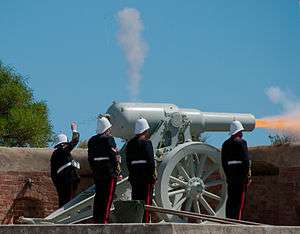RML 64 pounder 64 cwt gun
| RML 64 pounder 64 cwt gun | |
|---|---|
|
Fortification mounted MK III gun firing at Fort Glanville Conservation Park, South Australia | |
| Type |
Naval gun Fortification gun |
| Place of origin |
|
| Service history | |
| In service | 1865 - 190? |
| Used by | British Empire |
| Production history | |
| Designer | Woolwich Arsenal |
| Designed | 1864 |
| Manufacturer |
Woolwich Arsenal Elswick Ordnance Company |
| Variants | Mk I, II, III |
| Specifications | |
| Weight | 64-long-hundredweight (3,300 kg) |
| Length | 9 ft 10 inches[1] |
| Barrel length | 97.5 inches bore |
|
| |
| Shell | 64 pounds (29 kg)[2] |
| Calibre | 6.3 inches (160 mm) |
| Action | RML |
| Breech | none – muzzle-loading |
| Muzzle velocity |
wrought-iron tube : 1,252 feet per second (382 m/s) Mk III steel tube : 1,390 feet per second (420 m/s)[3] |
| Effective firing range | 5,000 yards (4,600 m)[2] |
The RML 64 pounder 64 cwt gun was a Rifled, Muzzle Loading (RML) naval, field or fortification artillery gun manufactured in England in the 19th century,[2] which fired a projectile weighing approximately 64 pounds (29 kg). "64 cwt" refers to the gun's weight rounded up to differentiate it from other "64-pounder" guns.
Description
The calibre of 6.3 inches was chosen to enable it to fire remaining stocks of spherical shells originally made for the obsolete 32 pounder guns if necessary.
Mark I (adopted in 1864) and Mark II (adopted 1866) guns, and Mark III guns made from 1867 - April 1871 had wrought-iron inner "A" tubes surrounded by wrought-iron coils.
Mark III guns made after April 1871 were built with toughened mild steel "A" tubes, and earlier Mark III guns were re-tubed with steel and were classified as a siege gun in land service. Remaining guns with iron tubes were used for sea service.[4]
Rifling of all guns consisted of 3 grooves, with a uniform twist of 1 turn in 40 calibres (i.e. 1 turn in 252 inches).[4]
Ammunition
The gun's standard shell was "common shell", for firing on troops in cover, ships and buildings, weighed 57.4 pounds (26.0 kg) when empty with a bursting charge of 7.1 pounds (3.2 kg). Shrapnel shells could also be fired; a 66.6 pounds (30.2 kg) shell with a 9-ounce (260 g) bursting charge propelling 234 metal balls.[5]
Surviving Examples of Guns

- Mk I, Mk II and Mk III guns at Fort George, near Inverness, Scotland, UK
- At Nothe Fort, Weymouth, UK
- A Mk III gun at Fort Brockhurst, Gosport, UK
- Mark III Gun number 17 on board HMS Gannet, Chatham Dockyard, UK
- Two Mark III guns at Pendennis Castle, Cornwall, UK
- At Fort Glanville, Adelaide, South Australia
- Mk III gun no. 739 of 1878 at Townsville, Queensland, Australia
- Two Mk III guns at Fort Lytton Historic Military Precinct, Brisbane, Australia[6]
- Lei Yue Mun Fort's Central Battery, Hong Kong
- 6 guns at Fort Siloso, Singapore includin Mark III gun No. 767 of 1874
- RML 64-pr 64 cwt Mk 3 at Albert Park, Auckland, Auckland, New Zealand
Surviving Examples of Ammunition
- RML 64pdr shell that has been fired, and RML 64 fuse at Fort Lytton Historic Military Precinct, Brisbane, Australia
See also
- RML 64 pounder 71 cwt gun : conversion of SBML 8 inch 65 cwt gun
Notes and references
- ↑ http://riv.co.nz/rnza/hist/gun/rifled5.htm
- 1 2 3 A Guide to Fort Glanville, South Australia. Semaphore Park, South Australia: The Fort Glanville historical association. 2000.
- ↑ 1,252 feet/second firing a 64-pound projectile with 8 pounds R.L.G. gunpowder is quoted for wrought-iron tubed guns in "Treatise on Construction and Manufacture of Service Ordnance, 1879", page 363. 1,390 feet/second firing a 65-pound projectile using 10 pounds R.L.G.4 gunpowder is quoted for Mk III steel tube gun in Table XII in "Text Book of Gunnery 1902".
- 1 2 Treatise on Construction and Manufacture of Service Ordnance, 1879, pages 292, 261-265
- ↑ "The 64pr. 64 cwt gun Mark III". Palmerston Forts Society, Fareham Hampshire U.K. Retrieved 2009-01-20.
- ↑ The two 1878 guns are still fired regularly "Gun-firing Re-enactment | Fort Lytton Historic Military Precinct". fortlytton.org.au. Retrieved 13 August 2016.
Bibliography
- Treatise on the Construction and Manufacture of Ordnance in the British Service. War Office, UK, 1879
- Text Book of Gunnery, 1902. LONDON : PRINTED FOR HIS MAJESTY'S STATIONERY OFFICE, BY HARRISON AND SONS, ST. MARTIN'S LANE
External links
| Wikimedia Commons has media related to RML 64 pounder 64 cwt Gun. |
- Handbook for the 64 - pr. R.M.L. gun of 64 cwt., marks I-III land service 1888, 1893, 1900, 1902 at State Library of Victoria
- Diagram of gun on 6 foot parapet platform mounting at Victorian Forts website
